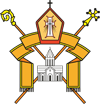Dilif (Dlivik) Village – Surb Vardan Zoravar (Saint Vartan the Warrior) church
The modern village of Dilif in Ninotsminda region was first mentioned in Armenian bibliography with the name Dlivek in 988, and with the name Dliv in 1595 in Ottoman tax lists. In contrast to many neighboring villages, the ancestors of the present-day residents of Dilif moved to Javakhk not from the province of Karno, but from Taron. They migrated from the villages of Mush, Karachoban and Kendikov [1].
The church named after Surb Vardan Zoravar (Saint Vartan the Warrior) in Dilif village was built in 1866. There is an engraving on the lintel of the entrance door of the church which says, “Saint Vardanants Church; village Dilif’’. It should be added that in the church registers of 1847-1885, until 1870 [2], the village’s church is mentioned as Surb Gevorg (Saint George), afterwards it is mentioned as Surb Vardan (Saint Vartan) [3].
The earliest information about the church named Surb Gevorg is recorded from 1839 to 1840 in the archival documents of the Georgian and Imeretian dioceses [4]. In the same years Rev. Father Manuel Meroyan and Rev. Father Hovhannes Hovhannisyan were the priests in Surb Gevorg church [5]. As of 1857, Surb Gevorg church owned two rooms donated by the public, the income of which was given to member of parliament Zakar Ter-Manvelyan [6]. In the 1880s, the church was named Surb Vardan and was mentioned as a built of stone structure with wooden roof [7]. In 1915, the number of the church's parishioners had reached 1242. [8].
Among the preserved places of pilgrimage in the village are Surb Minas (Saint Minas), Tevatoros, Davoyi Surb (Davo's Saint), Surb Grigor Lusavorich (Saint Gregory the Illuminator) and other sanctuaries. It should be mentioned that various religious books are kept in the houses of the villagers, many of which are kept in separate corners in houses and small houses of prayers and chapels built in the yards of the houses [9].
Architecture: The church is built of rough stone and mortar; it has a structure of a three-shipped dome, a type of basilica. The exception is the western facade which is built of hewn stone. The external dimensions of the church are 11x18 m. A metal belfry is built on the top of the western facade. The entrance is from the western side. A semicircular window opens from the front of the entrance. The inner area is divided into two ships by three pairs of columns, and there is one large hall in the central part.
The Holy Altar was built in the eastern side with its right and left sacristies. The baptismal font is placed on the northern wall [10].
School: The church also had its own parish school, about which archival documents provide information from the 1960s. In accordance with those documents, the school was opened with the means of the public in 1864 and had 20 students in that time [11].
Reconstruction and reconsecration: During the Soviet era, the church, like other churches, was closed and turned into a warehouse. In 2017, the church was renovated on the initiative of benefactors, who previously were living in the village of Dilif. The roof of the church was fixed, the dome was repaired and interior decoration activities were implemented. The Holy Altar and the Baptismal Font of the church were completely reconstructed [12].
On October 12, 2018, the church was reconsecrated by the Primate of the Armenian Diocese in Georgia, His Grace Bishop Vazgen Mirzakhanyan. In accordance with the consecration ritual of the Armenian Church, the Opening of the Door Service (Drnbatsek) was offered under the presidency of the Primate of the Armenian Diocese in Georgia, accompanied by Rev. Father Tigran Mkhitaryan, the Pastor of Saint Sarkis church in Dilisika and Rev. Father Gevorg Asatryan, the Pastor of Saint Karapet church in Gandza. The baptismal font, 16 columns and images that afterwards turned into icons were consecrated with Holy Muron (Chrism). Rev. Father Armash Poghosyan, the Pastor of Saint Sarkis church in Ninotsminda and nearby settlements celebrated the first Divine Liturgy in the newly-reconsecrated church.
At the conclusion of the Divine Liturgy, the cross-stone (khachkar) dedicated to the Battle of Sardarabad and the 100th anniversary of the restoration of the Armenian statehood was consecrated in the church courtyard. The reconsecration ceremony of the church was attended by representatives of local authorities, guests and pilgrims from different regions of Armenia, Georgia, and Russian Federation [13].
Diocese of the Armenian Apostolic Church in Georgia
Armenian Historical and Cultural Heritage Research Center in Georgia
[1] S. Karapetyan, Javakhk, Yerevan, 2006, p. 166.
[2] NAA, ֆ. 53, ց. 2, գ. 5540-5543; 5548-5552; 5557-5561.
[3] NAA, ֆ. 53, ց. 2, գ. 5544-5547; 5553-5556; 5562-5572.
[4] NAA, ֆ. 53, ց. 1, գ. 457, թ. 60; գ. 3800, թ. 4.
[5] In the same place, գ. 457, թ. 60.
[6] NAA, ֆ. 53, ց. 1, գ. 3830, թ. 37 շրջ.-38.
[7] ''Ardzaganq'', 1885, N 3, p. 41.
[8] NAA, ֆ. 56, ց. 15, գ. 795 /part 3/, թ. 239 շրջ.-240.
[9] A. Davtyan, Armenian and Armenian-populated settlements in Georgia, Yerevan, 1997, p. 110.
[10] Armenian Historical and Cultural Heritage Research Center in Georgia
Diocese of the Armenian Apostolic Church in Georgia
[11] NAA, ֆ. 53, ց. 1, գ. 3977, թ. 54 շրջ.-55.
[12] Press Department of the Armenian Diocese in Georgia
[13] http://armenianchurch.ge/hy/news/34-news/1828-dilif-srboc-vardananc.
 Հայերեն
Հայերեն  ქართული
ქართული  English
English  Русский
Русский 


